Effective October 31, 2018, we introduce two new battery sizes and phase out BPS-300 and BPS-500 batteries.
New Batteries
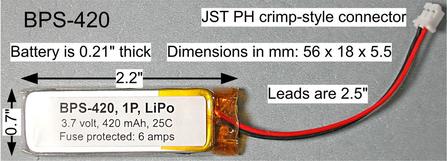
BPS-420
This is the battery of choice for HO-scale narrow-hooded diesels (GP series, for example). It replaces BPS-300 and BPS-500 batteries which will be discontinued.

BPS-1000
This adds a larger cell to the BPS battery range. It is intended for use in steam loco tenders and in S-scale diesel locos.
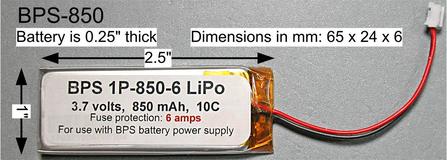
BPS-850
There is no change here. This is the most popular BPS battery used for HO-scale full-width diesels (E and F series, for example) most steam loco tenders and all larger scales (On30, On3, S). The new BPS-1000 is expected to replace it in some of these applications.
There is no change here. This is the most popular BPS battery used for HO-scale full-width diesels (E and F series, for example) most steam loco tenders and all larger scales (On30, On3, S). The new BPS-1000 is expected to replace it in some of these applications.
Discontinued
The 300 mAh cell is no longer available from manufacturer and is replaced by higher capacity 420 mAh cell which is same width and half an inch longer. The BPS-500 cell, which has been sourced from a different supplier, is replaced by the 420 so that all LiPo cells can be purchased from the same manufacturer.
Standard Configurations
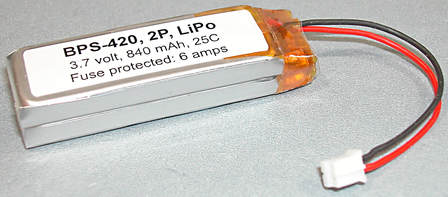
Each cell size will be available as 1P and 2P back-to-back assemblies. Integrated fuse protection is standardized at 6 amps to be compatible with latest version of Battery Power Supply (BPS-v4) which requires up to 4 amps battery current at full output.
"P" indicates cells are connected in parallel. Voltage is same as single cell (nominally 3.7 volts) and capacity adds so a 2P-420 battery provides 840 mAh.
25C indicates cell is rated for high discharge; specifically, 25 times cell capacity. That is, 25 x 420 mA equals 10.5 amps from one cell and 21 amps from 2 cells in parallel. This should remove any doubts regarding the importance of embedded fuse protection.
"P" indicates cells are connected in parallel. Voltage is same as single cell (nominally 3.7 volts) and capacity adds so a 2P-420 battery provides 840 mAh.
25C indicates cell is rated for high discharge; specifically, 25 times cell capacity. That is, 25 x 420 mA equals 10.5 amps from one cell and 21 amps from 2 cells in parallel. This should remove any doubts regarding the importance of embedded fuse protection.
Custom Configurations
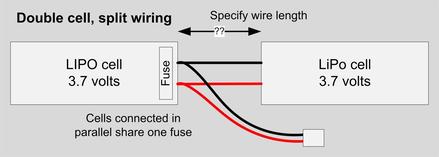
When a back-to-back arrangement is too thick for some applications, cells can be wired with an arbitrary length of wire between them. With the arrangement illustrated (right) cells share one fuse as is done with a back-to-back assembly. However, this leaves one cell with external wiring and no internal protection. Although the risk is low, this practice will be discontinued.
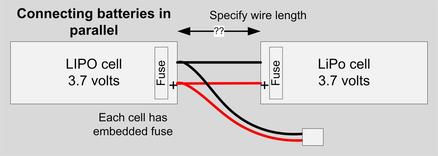
In future, separated 2P arrangements will use two 1P batteries (each with fuse) connected in parallel. One precaution with this arrangement is make sure cell voltages are approximately equal before connecting. The equalizing current surge created by a large voltage difference may be sufficient to blow one or both fuses. Be sure to connect positive to positive.